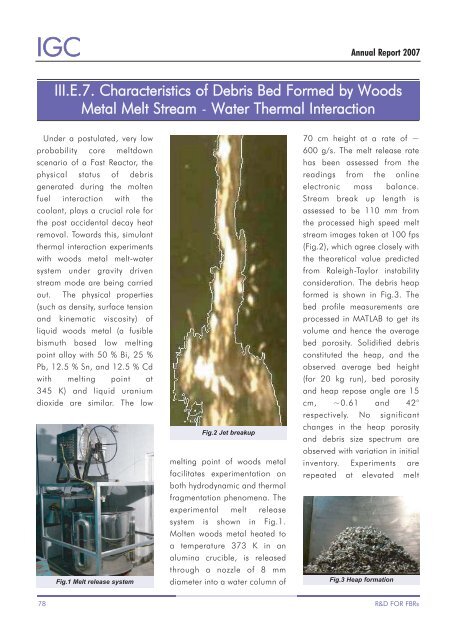IGCAR : Annual Report - Indira Gandhi Centre for Atomic Research
IGCAR : Annual Report - Indira Gandhi Centre for Atomic Research
IGCAR : Annual Report - Indira Gandhi Centre for Atomic Research
Create successful ePaper yourself
Turn your PDF publications into a flip-book with our unique Google optimized e-Paper software.
IGC<br />
<strong>Annual</strong> <strong>Report</strong> 2007<br />
III.E.7. Characteristics of Debris Bed Formed by Woods<br />
Metal Melt Stream - Water Thermal Interaction<br />
Under a postulated, very low<br />
probability core meltdown<br />
scenario of a Fast Reactor, the<br />
physical status of debris<br />
generated during the molten<br />
fuel interaction with the<br />
coolant, plays a crucial role <strong>for</strong><br />
the post accidental decay heat<br />
removal. Towards this, simulant<br />
thermal interaction experiments<br />
with woods metal melt-water<br />
system under gravity driven<br />
stream mode are being carried<br />
out. The physical properties<br />
(such as density, surface tension<br />
and kinematic viscosity) of<br />
liquid woods metal (a fusible<br />
bismuth based low melting<br />
point alloy with 50 % Bi, 25 %<br />
Pb, 12.5 % Sn, and 12.5 % Cd<br />
with melting point at<br />
345 K) and liquid uranium<br />
dioxide are similar. The low<br />
Fig.1 Melt release system<br />
Fig.2 Jet breakup<br />
melting point of woods metal<br />
facilitates experimentation on<br />
both hydrodynamic and thermal<br />
fragmentation phenomena. The<br />
experimental melt release<br />
system is shown in Fig.1.<br />
Molten woods metal heated to<br />
a temperature 373 K in an<br />
alumina crucible, is released<br />
through a nozzle of 8 mm<br />
diameter into a water column of<br />
70 cm height at a rate of ~<br />
600 g/s. The melt release rate<br />
has been assessed from the<br />
readings from the online<br />
electronic mass balance.<br />
Stream break up length is<br />
assessed to be 110 mm from<br />
the processed high speed melt<br />
stream images taken at 100 fps<br />
(Fig.2), which agree closely with<br />
the theoretical value predicted<br />
from Raleigh-Taylor instability<br />
consideration. The debris heap<br />
<strong>for</strong>med is shown in Fig.3. The<br />
bed profile measurements are<br />
processed in MATLAB to get its<br />
volume and hence the average<br />
bed porosity. Solidified debris<br />
constituted the heap, and the<br />
observed average bed height<br />
(<strong>for</strong> 20 kg run), bed porosity<br />
and heap repose angle are 15<br />
cm, ~0.61 and 42°<br />
respectively. No significant<br />
changes in the heap porosity<br />
and debris size spectrum are<br />
observed with variation in initial<br />
inventory. Experiments are<br />
repeated at elevated melt<br />
Fig.3 Heap <strong>for</strong>mation<br />
78 R&D FOR FBRs

















